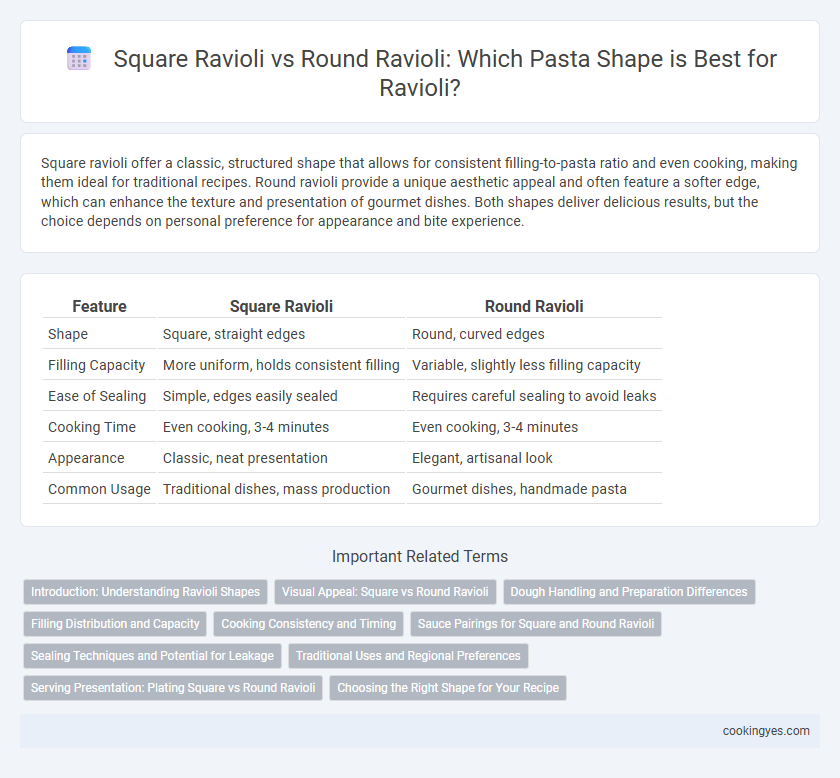Square ravioli offer a classic, structured shape that allows for consistent filling-to-pasta ratio and even cooking, making them ideal for traditional recipes. Round ravioli provide a unique aesthetic appeal and often feature a softer edge, which can enhance the texture and presentation of gourmet dishes. Both shapes deliver delicious results, but the choice depends on personal preference for appearance and bite experience.
Table of Comparison
| Feature | Square Ravioli | Round Ravioli |
|---|---|---|
| Shape | Square, straight edges | Round, curved edges |
| Filling Capacity | More uniform, holds consistent filling | Variable, slightly less filling capacity |
| Ease of Sealing | Simple, edges easily sealed | Requires careful sealing to avoid leaks |
| Cooking Time | Even cooking, 3-4 minutes | Even cooking, 3-4 minutes |
| Appearance | Classic, neat presentation | Elegant, artisanal look |
| Common Usage | Traditional dishes, mass production | Gourmet dishes, handmade pasta |
Introduction: Understanding Ravioli Shapes
Square ravioli offers uniform edges that seal fillings securely, optimizing cooking consistency and presentation quality. Round ravioli provides a softer, artisanal appearance and allows greater versatility in filling sizes due to its curved shape. Both shapes influence texture and sauce retention, making shape selection crucial for achieving desired culinary outcomes.
Visual Appeal: Square vs Round Ravioli
Square ravioli offer a clean, geometric appearance that highlights uniformity and precision, making them visually striking in plated dishes. Round ravioli present a softer, more organic silhouette that conveys a homemade, rustic charm appealing to artisanal pasta enthusiasts. The choice between square and round shapes significantly influences the overall visual presentation and perceived authenticity of the dish.
Dough Handling and Preparation Differences
Square ravioli requires precise folding and sealing of dough sheets to ensure uniform edges and prevent filling leakage, demanding consistent dough thickness and elasticity. Round ravioli often involves cutting dough with circular cutters which can accommodate slight variations in dough flexibility, making it easier to handle with thinner dough. Dough preparation for square shapes emphasizes even rolling and sharp corner handling, while round shapes allow smoother, more forgiving shaping and sealing techniques.
Filling Distribution and Capacity
Square ravioli offer a uniform filling distribution due to their even edges, allowing for consistent sealing and preventing filling from leaking during cooking. Round ravioli, with their curved shape, can sometimes lead to uneven filling distribution but provide a larger filling capacity per individual piece because of their shape. Both shapes influence cooking time and texture, with square ravioli often offering a more structured bite and round ravioli delivering a softer, more pliable pasta experience.
Cooking Consistency and Timing
Square ravioli typically offer more even cooking due to their uniform edges, allowing heat to penetrate consistently across the pasta. Round ravioli, with their curved shape, may cook slightly faster at the thinner center but risk uneven cooking near the thicker edges. Precise timing is essential for both shapes to avoid overcooking; square ravioli generally require a slightly longer boil for uniform doneness.
Sauce Pairings for Square and Round Ravioli
Square ravioli, with their larger surface area and defined edges, effectively hold thicker, cream-based sauces like Alfredo or mascarpone, allowing the sauce to cling and infuse each bite. Round ravioli, often smaller and more delicate, pair excellently with lighter sauces such as a simple sage butter or a subtle tomato basil, complementing rather than overpowering the filling. The shape influences the sauce distribution, making square ravioli ideal for hearty, robust sauces while round ravioli excel with smooth, lighter dressings that highlight flavor balance.
Sealing Techniques and Potential for Leakage
Square ravioli often feature crimped edges or a fork-pressed seal that creates a tight, uniform closure, minimizing the risk of filling leakage during cooking. Round ravioli typically rely on a pinched or folded edge seal, which can sometimes be less secure and more prone to opening under boiling conditions. Proper sealing technique and sufficient dough thickness are crucial in both shapes to maintain structural integrity and prevent leakage.
Traditional Uses and Regional Preferences
Square ravioli is traditionally favored in northern Italy, especially in regions like Piedmont and Lombardy, where it is often filled with meats, cheeses, or vegetables and served with butter or light sauces. Round ravioli, more common in central and southern Italy, particularly Tuscany and Lazio, tends to feature rustic fillings such as ricotta and spinach or meat, paired with robust tomato-based sauces. The shape influences not only presentation but also cooking technique and sauce adherence, reflecting distinct regional culinary traditions and preferences.
Serving Presentation: Plating Square vs Round Ravioli
Square ravioli offers a structured, modern aesthetic that enhances plating with clean lines and uniformity, making it ideal for minimalist or geometric presentations. Round ravioli provides a classic, rustic appeal that complements traditional Italian dishes, adding a soft, inviting shape that pairs well with hearty sauces and garnishes. Choosing between square and round shapes influences the visual impact and overall elegance of the pasta presentation on the plate.
Choosing the Right Shape for Your Recipe
Square ravioli offer structured edges that hold fillings securely and are ideal for thicker sauces, enhancing every bite's texture. Round ravioli provide a delicate, visually appealing shape that cooks evenly, making them perfect for lighter sauces or broths. Selecting the right shape depends on the desired sauce pairing and presentation, ensuring perfect flavor balance and mouthfeel.
Square ravioli vs Round ravioli for pasta shape Infographic

 cookingyes.com
cookingyes.com